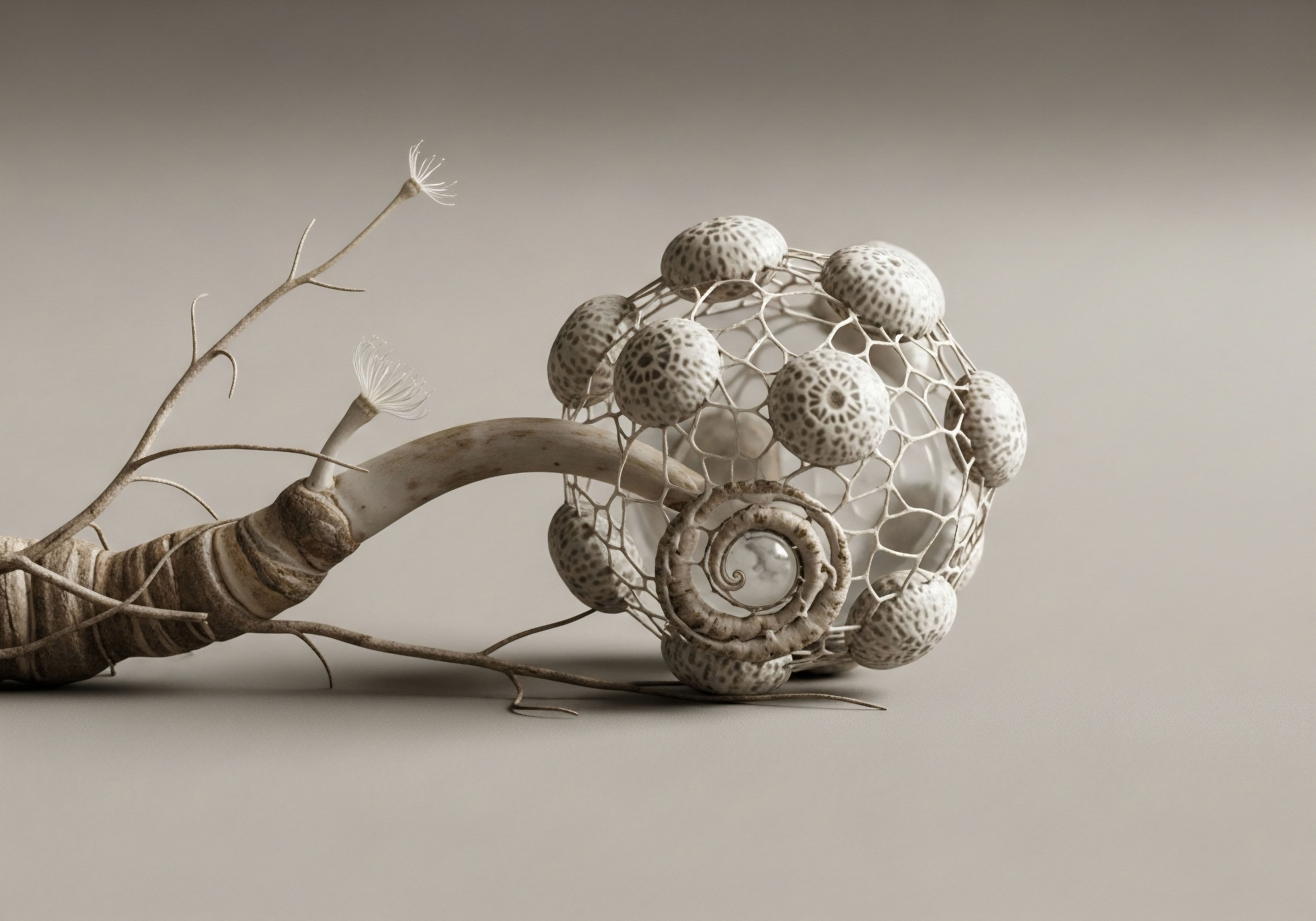

Fundamentals
The feeling is unmistakable. It is a subtle shift in your internal landscape, a sense of being out of sync with your own body. Perhaps it manifests as a persistent fatigue that sleep does not resolve, a quiet diminishment of physical and mental drive, or changes in your mood that seem to come from nowhere.
You may have noticed a frustrating change in your body composition, with stubborn fat accumulating in areas it never did before, despite your efforts in the gym and with your diet. These experiences are valid, and they are often the first signals of a deeper conversation happening within your endocrine system.
Your body is communicating a change in its internal chemistry, and understanding that dialogue is the first step toward reclaiming your vitality. The question of whether lifestyle changes can effectively lower high estradiol in men is a profound one, because it speaks to the very heart of personal agency in health. It is about learning the language of your own biology to guide it back toward its optimal state of function.
This exploration begins with a foundational respect for the molecules involved. Estradiol, a primary form of estrogen, has a vital and necessary presence in the male body. It contributes to maintaining bone density, supports cardiovascular health, and even plays a role in modulating libido and erectile function.
Its presence is a component of a healthy hormonal symphony. The issue arises when its levels become disproportionately high relative to testosterone, creating a state of imbalance that can generate the symptoms you may be experiencing. This is a state of hormonal miscommunication, where one voice in the conversation becomes too loud, drowning out the others and disrupting the system’s delicate equilibrium.

Estradiol’s Essential Role in Male Physiology
To effectively manage estradiol, one must first appreciate its purpose. In male physiology, estradiol is synthesized from testosterone in a process that is both normal and necessary. This biochemical conversion ensures that men have access to the protective benefits of this powerful hormone.
Healthy bones rely on estradiol to regulate the constant process of remodeling, where old bone is broken down and new bone is formed. Without sufficient estradiol, men are at a higher risk for osteopenia and osteoporosis, conditions characterized by brittle bones.
The brain also utilizes estradiol for cognitive functions, and the cardiovascular system benefits from its influence on cholesterol levels and the health of blood vessel linings. A certain level of estradiol is also required for healthy sexual function. The goal is achieving a balanced hormonal state, allowing estradiol to perform its supportive functions without dominating the endocrine environment.

The Source of Estradiol in Men the Aromatase Process
The primary pathway for producing estradiol in men is a biochemical reaction managed by an enzyme called aromatase. This enzyme is found in various tissues throughout the body, including bone, the brain, and blood vessels. Its most significant concentration, however, resides in adipose tissue, or body fat.
Aromatase acts as a conversion catalyst, taking testosterone molecules and transforming them into estradiol. This process is continuous and responsive to the body’s internal environment. The amount of aromatase activity directly influences how much testosterone is converted into estradiol. Consequently, the more adipose tissue a man carries, particularly visceral fat around the abdomen, the more aromatase his body produces.
This creates a larger capacity for converting testosterone into estradiol, which is a central mechanism behind elevated estrogen levels in men. Understanding this process reveals a clear and actionable target for intervention. By influencing the factors that control aromatase activity, you can directly influence your estradiol levels.
The body’s hormonal balance is a dynamic conversation, and high estradiol is a sign that this internal dialogue needs recalibration.

When the Conversation Becomes Unbalanced
When estradiol levels rise too high, the hormonal conversation is disrupted, leading to a cascade of noticeable symptoms. These are the tangible, lived experiences that signal an underlying imbalance. Men with elevated estradiol may experience a persistent and deep-seated fatigue that lingers even after a full night’s sleep.
Their motivation and competitive drive can wane, replaced by a sense of apathy or emotional hypersensitivity. Physical symptoms are also common, including water retention, which can cause a soft or puffy appearance, and gynecomastia, the development of breast tissue. Libido may decrease, and some men experience erectile dysfunction.
These symptoms are direct consequences of the hormonal imbalance. For instance, excess estradiol can interfere with the signaling pathways that support healthy erections. It can also send feedback to the brain that suppresses the production of testosterone, creating a self-perpetuating cycle of low testosterone and high estradiol. Recognizing these symptoms as biological signals, rather than personal failings, is an empowering step toward addressing the root cause.

Can You Truly Influence This System without Medication?
The answer is a definitive yes. The human body is a highly adaptive system that constantly responds to the inputs it receives from its environment. Lifestyle is the collection of these inputs. The foods you consume, the way you move your body, the quality of your sleep, and the management of your stress are all powerful modulators of your internal biochemistry.
These are not passive activities; they are direct instructions that influence everything from enzyme activity to gene expression. By making strategic, evidence-based changes to your lifestyle, you can directly target the mechanisms that lead to high estradiol.
You can reduce the amount of aromatase-producing adipose tissue, provide your body with the nutrients it needs to properly metabolize and excrete hormones, and create an internal environment that favors a healthy testosterone-to-estrogen ratio. This approach is about working with your body’s innate intelligence, using lifestyle as the primary tool to guide your hormonal systems back to a state of optimal function and balance.


Intermediate
Effectively lowering elevated estradiol through lifestyle modifications is a process of systematic recalibration. It involves a targeted approach that addresses the primary drivers of hormonal imbalance. Once you understand that high estradiol is often a consequence of excess aromatase activity and inefficient estrogen clearance, the path forward becomes clear.
It is a path built on four core pillars of intervention ∞ managing body composition, implementing strategic nutrition, optimizing physical activity, and regulating the stress and recovery cycle. These pillars work synergistically to create an internal environment that naturally favors lower estradiol levels and a healthier hormonal profile. This is an active process of taking control of the physiological levers that govern your endocrine health, moving beyond passive hope and into empowered action.

Pillar One Managing Body Composition to Reduce Aromatase
The most powerful non-medicinal strategy for lowering estradiol is reducing excess body fat. Adipose tissue is not simply an inert storage depot for energy; it is a dynamic endocrine organ that actively produces hormones and inflammatory signals. Its primary role in the context of high estradiol is as the main site of aromatase enzyme activity.
Visceral adipose tissue, the deep abdominal fat that surrounds the organs, is particularly active in this regard. A higher body fat percentage directly translates to a larger “factory” for converting your valuable testosterone into estradiol. Therefore, a structured plan aimed at reducing body fat is a direct intervention to decrease aromatase activity.
This is achieved through a sustained caloric deficit, where energy expenditure exceeds energy intake. The focus should be on fat loss while preserving lean muscle mass, as muscle is metabolically active and contributes to a healthier hormonal environment. This pillar is the foundation upon which all other strategies are built, as it addresses the primary source of excess estrogen production in many men.

Pillar Two Strategic Nutrition for Hormonal Health
The foods you consume provide the raw materials that can either support or hinder your body’s ability to maintain hormonal balance. A diet designed to lower estradiol focuses on two main objectives ∞ reducing aromatase activity and enhancing the body’s ability to clear excess estrogen. Certain foods contain natural compounds that can modulate the aromatase enzyme.
- Cruciferous Vegetables ∞ This category, which includes broccoli, cauliflower, cabbage, and Brussels sprouts, is rich in a compound called indole-3-carbinol (I3C). In the body, I3C is converted to diindolylmethane (DIM), which helps support healthy estrogen metabolism pathways in the liver.
- Mushrooms ∞ Certain types of mushrooms, particularly white button mushrooms, contain phytochemicals that have been shown to have a mild inhibitory effect on the aromatase enzyme.
- Zinc-Rich Foods ∞ Zinc is a mineral that plays a role in regulating aromatase. Including foods like pumpkin seeds, lentils, and lean meats can help ensure adequate zinc levels.
- High-Fiber Foods ∞ A diet rich in soluble and insoluble fiber from sources like vegetables, fruits, and whole grains supports gut health, which is critical for estrogen excretion. Fiber binds to estrogen in the digestive tract, ensuring its removal from the body.
In contrast, a diet high in processed foods, refined sugars, and excessive alcohol can promote inflammation and fat gain, thereby increasing aromatase activity. Alcohol, in particular, can place a burden on the liver, impairing its ability to effectively metabolize and clear estrogen from the bloodstream.
Strategic nutrition provides the body with the specific tools it needs to inhibit estrogen production and enhance its elimination.
The table below outlines key nutritional strategies and their mechanisms of action.
| Nutritional Strategy | Mechanism of Action | Food Examples |
|---|---|---|
| Increase Cruciferous Vegetable Intake | Provides Indole-3-Carbinol (I3C) and DIM, which support healthy estrogen metabolism in the liver. | Broccoli, cauliflower, kale, Brussels sprouts. |
| Boost Dietary Fiber | Binds to excess estrogen in the gut, promoting its excretion and preventing reabsorption. Supports a healthy gut microbiome. | Vegetables, fruits, legumes, whole grains, nuts, seeds. |
| Incorporate Natural Aromatase Inhibitors | Contain phytochemicals that can help modulate the activity of the aromatase enzyme. | White button mushrooms, red grapes (resveratrol), green tea (EGCG). |
| Ensure Adequate Zinc Intake | Zinc is a crucial cofactor for many enzymatic processes and may help regulate aromatase activity. | Lean meats, shellfish, legumes, pumpkin seeds. |
| Reduce Alcohol Consumption | Decreases the metabolic burden on the liver, allowing it to more efficiently process and clear estrogens from circulation. | Limit intake of beer, wine, and spirits. |

Pillar Three the Role of Physical Activity
Exercise is a potent modulator of the male endocrine system. A well-designed physical activity regimen can help lower estradiol through several mechanisms. Firstly, regular exercise, particularly a combination of resistance training and high-intensity interval training (HIIT), is highly effective for reducing body fat and increasing lean muscle mass.
This directly addresses the body composition pillar by shrinking the size of the body’s aromatase “factory.” Secondly, intense exercise has been shown to acutely boost testosterone levels. While this effect is transient, a consistent training habit contributes to a more favorable long-term hormonal environment.
Resistance training, in particular, by building muscle, increases the body’s overall metabolic rate, which aids in maintaining a healthy body composition. The goal is to engage in a consistent routine that challenges the body and promotes adaptations that support hormonal balance.

How Does the Body Process and Eliminate Estrogen?
Understanding the body’s estrogen clearance pathways illuminates why certain lifestyle strategies are so effective. The liver is the primary organ responsible for metabolizing estrogens and preparing them for excretion. This process occurs in two phases. In Phase I, enzymes known as cytochrome P450 enzymes begin to break down the estrogen molecules.
In Phase II, the liver attaches specific molecules to the estrogen metabolites in a process called conjugation. This “tags” them, making them water-soluble and ready for elimination from the body, primarily through bile into the intestines and through urine via the kidneys.
The efficiency of these detoxification pathways is dependent on a steady supply of specific nutrients, including B vitamins, magnesium, and antioxidants. A nutrient-poor diet, excessive alcohol intake, or a compromised liver can impair this process, leading to a buildup of estrogen in the body. Furthermore, the health of the gut microbiome plays a critical role in the final stage of excretion, a topic explored in greater depth in the next section.


Academic
A sophisticated understanding of estradiol regulation in men requires moving beyond individual lifestyle factors and adopting a systems-biology perspective. This view recognizes that the body is an interconnected network where the endocrine system, the gastrointestinal system, and the central nervous system are in constant communication.
High estradiol is rarely the result of a single failing component; it is a systemic imbalance. The most advanced and actionable insights in this area focus on the profound influence of the gut microbiome on hormone metabolism.
The community of microorganisms residing in your gut, collectively known as the microbiota, functions as a metabolic organ in its own right, with a specialized capacity to influence circulating levels of sex hormones. This collection of gut microbes that specifically metabolizes estrogens is termed the “estrobolome.” The composition and health of this microbial community can be a determining factor in whether your body efficiently excretes estrogen or reabsorbs it back into circulation, thereby contributing to elevated levels.

The Estrobolome a Systems Biology Perspective
The liver conjugates estrogens, packaging them for removal from the body via bile, which is secreted into the intestinal tract. In a healthy gut environment, these conjugated estrogens are then excreted in the feces. The estrobolome, however, introduces a critical variable into this process. Certain species of gut bacteria produce an enzyme called beta-glucuronidase.
This enzyme can “un-package” or deconjugate the estrogens that the liver has marked for excretion. This deconjugation process reverts the estrogen metabolites back into their biologically active forms. Once freed, these active estrogens can be reabsorbed from the gut back into the bloodstream through the enterohepatic circulation.
An unhealthy or imbalanced gut microbiome, a state known as dysbiosis, characterized by an overgrowth of beta-glucuronidase-producing bacteria, can lead to a significant increase in estrogen reabsorption. This creates a situation where the body is constantly recycling estrogen that it should be eliminating, directly contributing to a higher systemic estrogen load.

What Are the Implications of an Unhealthy Estrobolome?
An unhealthy estrobolome can create a vicious cycle that perpetuates hormonal imbalance. The increased reabsorption of estrogen raises circulating estradiol levels. This elevated estradiol, in turn, provides feedback to the central nervous system, specifically the hypothalamus and pituitary gland. This is the central control system for male sex hormone production, known as the Hypothalamic-Pituitary-Gonadal (HPG) axis.
High estradiol signals to the pituitary gland to reduce its output of Luteinizing Hormone (LH). Since LH is the primary signal that tells the Leydig cells in the testes to produce testosterone, a reduction in LH leads to lower testicular testosterone production. This creates a state of secondary, or hypogonadotropic, hypogonadism, where low testosterone and high estradiol coexist, driven in part by a dysfunctional gut environment. The composition of the estrobolome is therefore a critical leverage point for intervention.
The gut microbiome acts as a final checkpoint for hormone excretion, with the power to either clear estrogens or send them back into circulation.
Modulating the gut microbiome to favor a healthy estrobolome is achieved primarily through diet. A diet rich in diverse plant fibers ∞ prebiotics ∞ provides the necessary fuel for beneficial bacteria to thrive. These bacteria, such as species from the Lactobacillus and Bifidobacterium genera, generally produce low levels of beta-glucuronidase. In contrast, a diet high in processed foods and low in fiber can favor the growth of bacteria that produce high levels of this enzyme.
The following table details key bacterial players in the estrobolome and their general impact on estrogen metabolism.
| Bacterial Genus/Group | Primary Metabolic Role | Impact on Estrogen Levels |
|---|---|---|
| Clostridia | Many species in this class are high producers of beta-glucuronidase. | Promotes deconjugation and reabsorption, potentially increasing circulating estrogen. |
| Bacteroides | A diverse genus with varied roles. Some species can produce beta-glucuronidase. | A high Bacteroides to Firmicutes ratio is often associated with gut health, but specific species matter. |
| Lactobacillus | Generally low producers of beta-glucuronidase. Associated with gut barrier integrity. | Supports a healthy gut environment that favors proper estrogen excretion. |
| Bifidobacterium | Considered a beneficial genus, low in beta-glucuronidase activity. | Helps maintain a balanced microbiome, reducing the potential for estrogen reabsorption. |

What Are the Implications of Environmental Xenoestrogens?
A comprehensive discussion of estrogenic load must also consider exposure to environmental xenoestrogens. These are chemical compounds found in many industrial and consumer products that have estrogen-like activity in the body. They can bind to estrogen receptors and contribute to the overall estrogenic burden, further disrupting hormonal balance.
Key sources of xenoestrogens include Bisphenol A (BPA) and phthalates, which are commonly found in plastics, the lining of food cans, and personal care products. Pesticides and herbicides used in conventional agriculture are another significant source. While the impact of any single exposure may be small, the cumulative effect of chronic, low-dose exposure can be significant.
A lifestyle aimed at lowering estradiol should therefore include strategies to minimize exposure to these compounds. This includes choosing fresh, organic produce when possible, using glass or stainless steel containers for food storage instead of plastic, and selecting personal care products that are free from phthalates and other known endocrine disruptors. This approach reduces the external estrogenic load on the body, making it easier to manage the internally produced estrogens.

References
- Villareal, R. et al. “Aromatase Inhibitors Plus Weight Loss Improves the Hormonal Profile of Obese Hypogonadal Men Without Causing Major Side Effects.” Frontiers in Endocrinology, vol. 11, 2020, p. 277.
- Flores, R. et al. “The Richness of the Fecal Microbiome in Postmenopausal Women Is Associated with Serum Estrogen Metabolites.” Journal of the National Cancer Institute, vol. 104, no. 12, 2012, pp. 949-59.
- Shin, J.-H. et al. “Gut Microbiota and Sex Hormone-Related Diseases.” Frontiers in Immunology, vol. 10, 2019, p. 2029.
- Kornman, K. S. and W. J. Loesche. “The subgingival microbial flora during pregnancy.” Journal of Periodontal Research, vol. 15, no. 2, 1980, pp. 111-22.
- “6 Natural Ways to Lower Estrogen in Men.” Rupa Health, 30 Apr. 2024.
- “Effective Treatment for Men with High Estrogen.” Nova IVF Fertility.
- “What Men Need to Know About Aromatase.” Renew Youth, 15 Jan. 2016.
- “Roles of Sex Hormones and Gender in the Gut Microbiota.” Journal of Neurogastroenterology and Motility, vol. 24, no. 3, 2018, pp. 347-360.
- “The Gut Microbiome and Sex Hormone-Related Diseases.” Frontiers in Microbiology, vol. 12, 2021, p. 711137.
- “Potential relationship of the gut microbiome with testosterone level in men ∞ a systematic review.” World Journal of Men’s Health, vol. 42, 2024, e42.

Reflection

Charting Your Own Path
The information presented here is a map, detailing the intricate biological landscape that governs your hormonal health. It illuminates the pathways, identifies the key players, and reveals the powerful levers that are within your control. This knowledge is the essential first step. The next step is a personal one.
It involves looking at this map and plotting your own course, based on your unique experiences, symptoms, and goals. Your body is constantly providing you with feedback. Learning to listen to that feedback ∞ to connect how you feel with the choices you make each day ∞ is the art of personalized wellness.
This journey is about becoming an active participant in your own health, using this understanding as a compass to guide you toward a state of renewed vitality and optimal function. The potential for recalibration lies within your own systems, waiting for the right signals to begin.



